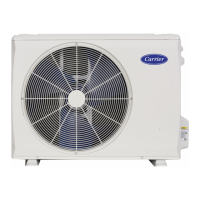38MURA: Installation Instructions
Manufacturer reserves the right to change, at any time, specifications and designs without notice and without obligations.
14
Wiring
All wires must be sized per NEC (National Electrical Code) or CEC
(Canadian Electrical Code) and local codes. Use Electrical Data table
MCA (minimum circuit amps) and MOCP (maximum over current
protection) to correctly size the wires and the disconnect fuse or breakers
respectively.
Power wiring
1. Remove the electric cover of the outdoor unit.
2. Connect the fork terminal to the terminals.
3. Match the wire labels with the labels on the terminal block.
4. Firmly screw the fork terminal of each wire to its corresponding
terminal.
5. Insulate unused wires with electrical tape. Keep them away from any
electrical or metal parts.
6. Reinstall the cover of the electric control box
Fig. 20 —Remove Electrical Cover
Fig. 21 — High Voltage Power Connections
Communication wiring
There are two options available to establish communication between the
outdoor unit and approved indoor unit.
Fig. 22 —Option 1: Non-polarity RS485 Communication
Fig. 23 —Option 2: 24V Communication
NOTES:
1. Do not use the thermostat wire for any RS-485 connection between
indoor and outdoor units.
2. All connections between the indoor and outdoor units must be made as
shown in Figures 22 - 23.
OPTIONS
COMMUNICATION TYPE RECOMMENDED CABLE SIZE
1
Non-Polarity RS485
Communication (S1 - S2)
16 AWG (stranded shielded)
2 24V communication
18 AWG 8 conductor thermostat
wire
ON
S1
1 2 3 4
CN6
S1
R C Y1 Y2 L
S2 B W D
TO INDOOR UNIT
ON
Outdoor Unit
Only Mode
1 2 3 4
CN6
TO 24V THERMOSTAT
S1
R C Y1 Y2 L
S2 B W D
S1
Power needs to be OFF before dip switch adjustments.
CAUTION
EQUIPMENT DAMAGE HAZARD
Failure to follow this caution may result in equipment damage or
improper operation. Wires should be sized based on NEDC and
local codes.
WARNING
EQUIPMENT DAMAGE HAZARD
Failure to follow this caution may result in equipment damage or
improper operation. Be sure to comply with local codes while
running wire from the indoor unit to the outdoor unit. Every wire
must be connected firmly. Loose wiring may cause the terminal to
overheat or result in unit malfunction. A fire hazard may also exist.
Ensure all wiring is tightly connected.
No wire should touch the refrigerant tubing, compressor or any
moving parts. Disconnecting means must be provided and shall be
located within sight and readily accessible from the air conditioner.
Connecting cable with conduit shall be routed through the hole in
the conduit panel.
CAUTION

